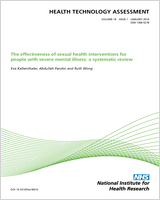Included under terms of UK Non-commercial Government License.
NCBI Bookshelf. A service of the National Library of Medicine, National Institutes of Health.
Blyth M, Anthony I, Francq B, et al. Diagnostic accuracy of the Thessaly test, standardised clinical history and other clinical examination tests (Apley’s, McMurray’s and joint line tenderness) for meniscal tears in comparison with magnetic resonance imaging diagnosis. Southampton (UK): NIHR Journals Library; 2015 Aug. (Health Technology Assessment, No. 19.62.)

Diagnostic accuracy of the Thessaly test, standardised clinical history and other clinical examination tests (Apley’s, McMurray’s and joint line tenderness) for meniscal tears in comparison with magnetic resonance imaging diagnosis.
Show details- Likelihood ratio for negative test
How many times more likely you are to not have a meniscal tear if you have a negative test compared with someone who has a positive test.
- Likelihood ratio for positive test
How many times more likely you are to have a meniscal tear if you have a positive test compared with someone who has a negative test.
- Musculoskeletal clinician
Orthopaedic specialist knee surgeon or extended scope physiotherapist with specialist knee interest (operating in a secondary care orthopaedic setting).
- Negative predictive value
The proportion of patients with a negative test who do not have a meniscal tear.
- Odds ratio
Diagnostic odds ratio of a test is the ratio of the odds of positivity in subjects with a tear relative to the odds in subjects without a tear. It is calculated according to the formula: odds ratio = (true positive/false negative)/(false positive/true negative).
- Positive predictive value
The proportion of patients with a positive test who actually have a meniscal tear.
- Primary care clinician
General practitioner- or community-based physiotherapist.
- Sensitivity
The proportion of those patients with a meniscal tear who are correctly identified as positive by the test. Low sensitivity indicates a high rate of false-negative tests.
- Specificity
The proportion of those patients without a meniscal tear who are correctly identified as negative by the test. Low specificity indicates a high rate of false-positive tests.
- Glossary - Diagnostic accuracy of the Thessaly test, standardised clinical histo...Glossary - Diagnostic accuracy of the Thessaly test, standardised clinical history and other clinical examination tests (Apley’s, McMurray’s and joint line tenderness) for meniscal tears in comparison with magnetic resonance imaging diagnosis
- Summary and protocol for the randomised controlled trial as originally planned -...Summary and protocol for the randomised controlled trial as originally planned - The relative clinical effectiveness and cost-effectiveness of three contrasting approaches to partner notification for curable sexually transmitted infections: a cluster randomised trial in primary care
- Phase 2: identifying improvements - The relative clinical effectiveness and cost...Phase 2: identifying improvements - The relative clinical effectiveness and cost-effectiveness of three contrasting approaches to partner notification for curable sexually transmitted infections: a cluster randomised trial in primary care
- Phase 4: intensive recruitment by external researchers - The relative clinical e...Phase 4: intensive recruitment by external researchers - The relative clinical effectiveness and cost-effectiveness of three contrasting approaches to partner notification for curable sexually transmitted infections: a cluster randomised trial in primary care
- Method - Clinical and cost-effectiveness of an adapted intervention for preschoo...Method - Clinical and cost-effectiveness of an adapted intervention for preschoolers with moderate to severe intellectual disabilities displaying behaviours that challenge: the EPICC-ID RCT
Your browsing activity is empty.
Activity recording is turned off.
See more...